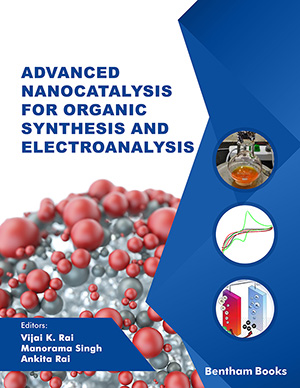
Abstract
The marine environment is considered as a precious source of novel marinederived natural products which offer valuable, safer and affordable promising compounds. Various universities and pharmaceutical industries are more and more interested in these novel compounds due to their exceptional health benefits. Unique ingredients found in the marine biosphere are polysaccharides, polyphenols, polyunsaturated fatty acids (PUFA), enzymes and bioactive peptides, minerals and vitamins to name a few. In order, to exploit sustainably the treasures of the ocean, in depth understanding and research are a must to pave the way for a better future. This review focuses mainly on the structure, biological properties and applications of some polysaccharides derived from marine macroalgae, marine fauna as well as exopolysaccharides (EPS) from marine microorganisms.
Keywords: Marine-derived polysaccharides, macroalgae, marine fauna, EPS.
Current Organic Chemistry
Title:Structure, Biological Properties and Applications of Marine-derived Polysaccharides
Volume: 20 Issue: 19
Author(s): Bibi Nazia Auckloo and Bin Wu
Affiliation:
Keywords: Marine-derived polysaccharides, macroalgae, marine fauna, EPS.
Abstract: The marine environment is considered as a precious source of novel marinederived natural products which offer valuable, safer and affordable promising compounds. Various universities and pharmaceutical industries are more and more interested in these novel compounds due to their exceptional health benefits. Unique ingredients found in the marine biosphere are polysaccharides, polyphenols, polyunsaturated fatty acids (PUFA), enzymes and bioactive peptides, minerals and vitamins to name a few. In order, to exploit sustainably the treasures of the ocean, in depth understanding and research are a must to pave the way for a better future. This review focuses mainly on the structure, biological properties and applications of some polysaccharides derived from marine macroalgae, marine fauna as well as exopolysaccharides (EPS) from marine microorganisms.
Export Options
About this article
Cite this article as:
Nazia Auckloo Bibi and Wu Bin, Structure, Biological Properties and Applications of Marine-derived Polysaccharides, Current Organic Chemistry 2016; 20 (19) . https://dx.doi.org/10.2174/1385272820666160202003944
| DOI https://dx.doi.org/10.2174/1385272820666160202003944 |
Print ISSN 1385-2728 |
| Publisher Name Bentham Science Publisher |
Online ISSN 1875-5348 |
Call for Papers in Thematic Issues
Advances of Heterocyclic Chemistry with Pesticide Activity
Global food safety and security will continue to be a global concern for the next 50 years and beyond. Plant diseases have had a significant impact on food safety and security throughout the entire food chain, from primary production to consumption. While conventional chemical pesticides have been traditionally used for ...read more
Carbohydrates conversion in biofuels and bioproducts
Biomass pretreatment, hydrolysis, and saccharification of carbohydrates, and sugars bioconversion in biofuels and bioproducts within a biorefinery framework. Carbohydrates derived from woody biomass, agricultural wastes, algae, sewage sludge, or any other lignocellulosic feedstock are included in this issue. Simulation, techno-economic analysis, and life cycle analysis of a biorefinery process are ...read more
Catalytic C-H bond activation as a tool for functionalization of heterocycles
The major topic is the functionalization of heterocycles through catalyzed C-H bond activation. The strategies based on C-H activation not only provide straightforward formation of C-C or C-X bonds but, more importantly, allow for the avoidance of pre-functionalization of one or two of the cross-coupling partners. The beneficial impact of ...read more
Cutting-edge technology for the development of electrochemical sensors
Electrochemistry based point of care diagnostics is a powerful tool which can revolutionize the current concept of personalize health care industry. There have been several efforts to amalgamate cutting edge technologies (nanotechnology, surface technology, anti-biofouling strategies) while developing assays. The success of each electrochemical sensor is very dependable upon how ...read more
Related Journals
 79
79 1
1 1
1 1
1
- Author Guidelines
- Graphical Abstracts
- Fabricating and Stating False Information
- Research Misconduct
- Post Publication Discussions and Corrections
- Publishing Ethics and Rectitude
- Increase Visibility of Your Article
- Archiving Policies
- Peer Review Workflow
- Order Your Article Before Print
- Promote Your Article
- Manuscript Transfer Facility
- Editorial Policies
- Allegations from Whistleblowers
- Announcements
Related Articles
-
Andrographolide Inhibits Proliferation of Colon Cancer SW-480 Cells <i>via</i> Downregulating Notch Signaling Pathway
Anti-Cancer Agents in Medicinal Chemistry Defensive and Offensive Cross-Reactive Antibodies Elicited by Pathogens: The Good, the Bad and the Ugly
Current Medicinal Chemistry New Approaches With Natural Product Drugs for Overcoming Multidrug Resistance in Cancer
Current Pharmaceutical Design Ocular Toxicities in Cancer Therapy: Still Overlooked
Current Cancer Therapy Reviews The Role of SAPK/JNK Pathway in the Synergistic Effects of Metformin and Dacarbazine on Apoptosis in Raji and Ramos Lymphoma Cells
Current Molecular Pharmacology Polymeric Nanoparticles to Combat Squamous Cell Carcinomas in Patients with Dystrophic Epidermolysis Bullosa
Recent Patents on Nanomedicine Novel Nanocolloidal Carriers for Noninvasive Vaccine Delivery
Current Drug Therapy Restoring TRAIL Induced Apoptosis Using Naturopathy. Hercules Joins Hand with Nature to Triumph Over Lernaean Hydra
Current Genomics Biology of Cox-2: An Application in Cancer Therapeutics
Current Drug Targets Transdermal Delivery of 5-Fluorouracil for Induced Ehrlich Ascites Carcinoma Tumor in Balb/c Mice and Pharmacokinetic Study
Recent Patents on Anti-Cancer Drug Discovery Quality Survival with Advanced Cervical Cancer
Current Women`s Health Reviews Src Tyrosine Kinase Inhibition Suppresses Lymphangiogenesis In Vitro and In Vivo
Current Cancer Drug Targets Lipoprotein Like Nanoparticles Used in Drug and Gene Delivery
Current Pharmaceutical Design Hypoxia and Oxidative Stress in the Pathogenesis of Gynecological Cancers and in Therapeutical Options
Current Cancer Therapy Reviews Gene Therapy Using IL-12 Family Members in Infection, Auto-Immunity, and Cancer
Current Gene Therapy Outfielders Playing in the Infield: Functions of Aging-Associated "Nuclear" Proteins in the Mitochondria
Current Molecular Medicine Bestatin as an Experimental Tool in Mammals
Current Drug Metabolism Hybrid Pharmacophore Design and Synthesis of Naphthalimide– Benzimidazole Conjugates as Potential Anticancer Agents
Letters in Drug Design & Discovery Emerging Trends and Potential Prospects in Vaginal Drug Delivery
Current Drug Delivery Tailored Angiogenesis Inhibition in Cancer Therapy: Respecting the Heart to Improve the Net Outcome
Current Signal Transduction Therapy
























